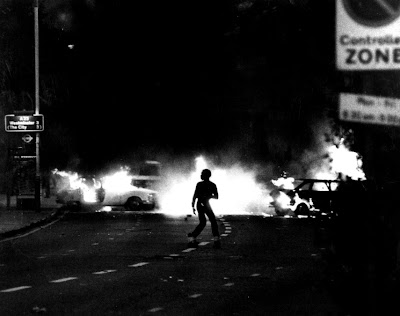“It is noh mistri / we mekkin histri” – Linton Kwesi Johnson

 In 1978 Margaret Thatcher made an infamous speech asserting that Britain “might be rather swamped by people of a different culture”. The Metropolitan police, I suppose intentionally, wittily thought that ‘Operation Swamp 81′ would be a good name for the overt stop and search policy they introduced at the beginning of April 1981.
In 1978 Margaret Thatcher made an infamous speech asserting that Britain “might be rather swamped by people of a different culture”. The Metropolitan police, I suppose intentionally, wittily thought that ‘Operation Swamp 81′ would be a good name for the overt stop and search policy they introduced at the beginning of April 1981.
The Met operated this policy under the ‘sus’ law (actually a very old law and officially known as the 1824 Vagrancy Act). In order to stop someone, police needed only ‘sus’, or suspicion, that they might be intending to commit a crime. To a lot of people at the time it was obvious that the police were using the ‘sus’ laws on the basis of racial prejudice.
On 10 April 1981, the police tried to assist a young Black man who had been stabbed in the back and a rumour quickly went around that the police were trying to arrest the injured man, rather than take him to hospital. A crowd of black youths took him from the police by force and drove him to St Thomas’s hospital by car. Tensions increased, especially as Operation Swamp searches continued the next day, and with the arrest of another man outside a minicab office serious violence suddenly sparked off.


Within half an hour, according to Brixton resident Darcus Howe, a group of young men took command and directed groups of ‘insurgents’ through the alleyways and passages that linked lots of central Brixton. Barricades were put up and crude petrol bombs were constructed – these would be the first molotov cocktails used in the UK outside Northern Ireland. The men also organised scouts, who could move quickly around the area on roller skates and bicycles. Suddenly, as Howe put it – “A spontaneous social explosion transformed itself into an organised revolt”.
 The police were at a massive disadvantage, not only did they have no experience of this kind of inner-city rioting, most of them had been brought in from other parts of London and had no idea as to the layout of Brixton. Their equipment was next to useless, and for shields they had to grab any dustbin lids they could lay their hands on. When plastic riot shields were brought to the area the police had had no training to use them and then found they weren’t flame resistant. At one point a rioter came up to the line of shields, tipped some whisky, stolen from a looted off-licence, over an officer and tried to set light to him.
The police were at a massive disadvantage, not only did they have no experience of this kind of inner-city rioting, most of them had been brought in from other parts of London and had no idea as to the layout of Brixton. Their equipment was next to useless, and for shields they had to grab any dustbin lids they could lay their hands on. When plastic riot shields were brought to the area the police had had no training to use them and then found they weren’t flame resistant. At one point a rioter came up to the line of shields, tipped some whisky, stolen from a looted off-licence, over an officer and tried to set light to him.
Buildings were torched, including a school in Effra Road, the Windsor Castle pub, and the post office. Most of the violence was concentrated along Railton Road, locally known as the ‘front line’. Serious looting began the next evening but by 10pm that night, the police had begun to regain control. Although sporadic fighting and looting continued through the night.
By the time the violence had subsided, over 360 people had been injured, 28 premises burned and another 117 damaged and looted. Over 100 vehicles, including 56 police vehicles, were damaged or destroyed during the rioting. The police arrested 82 people.



Throughout the country during the summer of 1981 places such as Handsworth, Southall, Toxteth, and Moss Side exploded into more rioting and violence.
After the Scarman report on the riots was released, the ancient Vagrancy Act (older than the Metropolitan Police itself) was no longer law, However there were two more riots in Brixton, albet of not quite the intensity, in 1985 and 1991.




